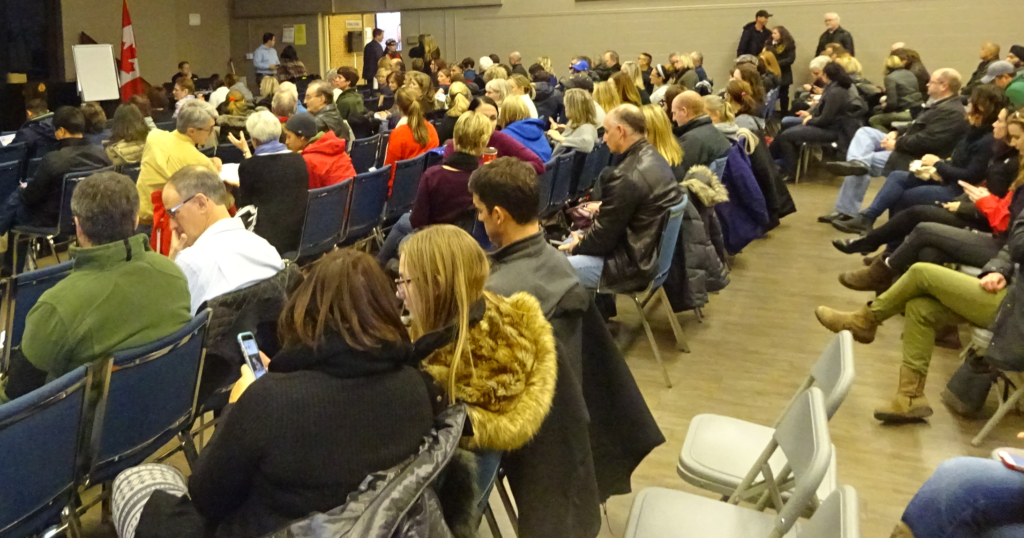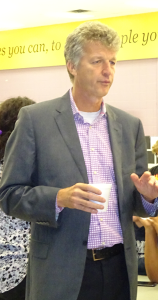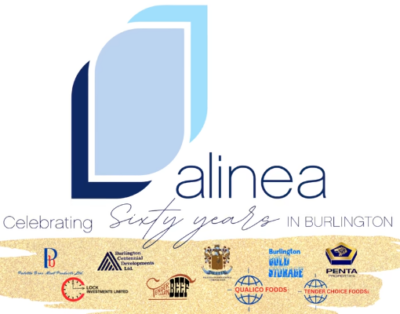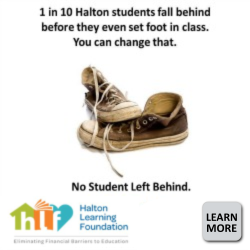 By Pepper Parr
By Pepper Parr
December 10th, 2016
BURLINGTON, ON
The data set out below is now correct.
It was the first public meeting of the Program and Accommodation Review Committee (PARC). There was an audience of about 300 people.
The audience was told that the meeting was to gather the perceptions of the people attending. This was going to be done by an interactive process that would put questions up on a large screen. People in the audience would use hand held devices to click a number indicating their answer.

There were not many empty seats – and there were few satisfied parents.
The first question was – who are you and where are you from – phrased a little differently – here is what went up on the screen – the results are shown in BOLD RED
Question 1: Which high school are your representing tonight? The number beside the school was the number people in the audience would key in. The screen displayed a number that indicated how many devices had been handed out and another number showing how many people had responded.
7. Aldershot 7
6. Dr. Frank J. Hayden 43
5. Lester B. Pearson 43
4. Nelson Public 6
3. Robert Bateman 5
2. Burlington Central 150
1. M.M. Robinson 2
It was clear from the start that the auditorium was filled with Central high school people.
They were asked 25 questions that were broken out into four different themes..
Programming and enrollment
Physical state of existing schools
Geographical and transportation issues
Fiscal responsibility and future planning
There was some discussion after each theme was covered off. The Ipsos facilitator made a strategic error in cutting off discussion in order to keep the meeting within the two hour time frame he had. He did loosen up later but by that time he had lost the confidence of the audience.
Ipsos was serving as a third-party gatherer of information. Both the facilitator and the meeting chair Scott Poderabac, a HDSB Superintendent, pointed out again and again that they were in the early stage of discussion and information gathering and that there were multiple ways to provide feedback:
The audience was told that a final decision on a school closing lies with Board of Trustees and that the PARC served as the official conduit for information shared between Trustees and school communities. It also provides feedback on options considered in Director’s Preliminary Report (option 19)
Board staff would be compiling the feedback from PARC and broader community to make up Community Consultation section of final staff report to Trustees. There would be a minimum of four working meetings of the PARC and PARC members will solicit input from the communities they represent.
The audience was told that the work being done is rooted in the 13 PARC Framework factors:
• Range of mandatory and optional programs
• Viability of Program – number of students required to offer and maintain program in an educationally sound and fiscally responsible way; Continuity of placement and possible relocation of regional programs within the review area
• Physical and environmental state of existing schools
• Proximity to other schools (non-bus distances, natural boundaries, walking routes)
• Accommodation of students in permanent school facilities and minimal use of portable classrooms
• Balance of overall enrollment in each school in the area to maximize student access to programs, resources, and extra-curricular opportunities and avoid over and underutilization of buildings
• Expansion and placement of new ministry or board programs
• Stable, long-term boundaries to avoid frequent boundary changes
• Cost effectiveness of transportation
• Fiscal responsibilities
• Existing and potential community use and facility partnerships
• Goals and focus of the current multi-year plan
There was very little explanation on these 13 factors and there didn’t seem to be much in the way of opportunity to revise them.
The option that had been determined by Stuart Miller, Director of Education was what has been named Option 19 which was:
Lester B. Pearson HS closes
Burlington Central HS closes
Remove French Immersion Program from Dr. Frank J. Hayden SS
and redirect to M.M. Robinson HS
Add French Immersion program to Robert Bateman HS, expand catchment for Robert Bateman HS and alter French Immersion catchment for Nelson HS
The meeting then moved into the first theme 1: Programming and Enrollment
Qx 2: How important is the availability of mandatory / core courses for your child(ren) within your home school?
3. Very Important 187
3. Somewhat Important 58
2. Not Very Important 12
1. Not at all Important 3
Qx 3: How acceptable is it to attend a school outside of a home school for mandatory / core programming for your child(ren)?
4. Very Acceptable 22
3. Somewhat Acceptable 42
2. Not Very Acceptable 64
1. Not at all Acceptable 135
Qx 4: How important is the availability of optional / elective courses within your home school for your child(ren)?
4. Very Important 94
3. Somewhat Important 117
2. Not Very Important 38
1. Not at all Important 14
Qx 5: How acceptable is it for your child(ren) to attend a school outside of a home school for optional/elective courses?
4. Very Acceptable 37
3. Somewhat Acceptable 92
2. Not Very Acceptable 70
1. Not at all Acceptable 62
Qx 6: How willing are you to have your child(ren) take a mandatory/core course in an alternative method (e.g., summer school, night school, e-learning or attend another school?
4. Very Willing 55
3. Somewhat Willing 54
2. Not Very Willing 57
1. Not at all Willing 96
Qx 7: How willing are you to have your child(ren) take a optional/elective course in an alternative method (e.g., summer school, night school, e-learning or attend another school?
4. Very Willing 90
3. Somewhat Willing 74
2. Not Very Willing 46
1. Not at all Willing 49
Qx 8: How important is it for you high school to offer a full range of pathway programming (e.g., workplace, college, university)?
4. Very Important 120
3. Somewhat Important 89
2. Not Very Important 33
1. Not at all Important 15
Qx 9: How concerned are you that your child(ren) has access to appropriate learning facilities (e.g., kitchens, science labs, gyms, libraries)?
4. Very Concerned 165
3. Somewhat Concerned 58
2. Not Very Concerned 16
1. Not at all Concerned 19
Qx 10: How concerned are you that some high schools have large amounts of specialized learning spaces that remain underutilized?
4. Very Concerned 18
3. Somewhat Concerned 56
2. Not Very Concerned 92
1. Not at all Concerned 92
Qx 11: How important is it for your home school to have a full range of extracurricular activities (e.g., drama, arts, athletics, clubs) for your child(ren)?
4. Very Important 121
3. Somewhat Important 92
2. Not Very Important 35
1. Not at all Important 13
Qx 12: How likely are you to support your child(ren) participating in extracurricular activities at another school?
4. Very Likely 72
3. Somewhat Likely 69
2. Not Very Likely 49
1. Not at all Likely 68
Qx 13: How important is it for your child to have access to the highest level of competition in athletics?
4. Very Important 19
3. Somewhat Important 30
2. Not Very Important 170
1. Not at all Important 141
Discussion
Peter Menet wanted to know if the board was collecting the data as raw information – it was. When another speaker commented on how bad the questions were there was an immediate burst of applause. The audience was again told that this was an early stage of the process.
Some speakers said they felt answering the questions the way they were put was to be working against their own interests. Others felt the questions were “sketchy” and that just about everything was weighted towards the “bigger is better” approach.
Theme 2: Physical State of Existing Schools
Qx 14: How important is the physical condition of your existing school to you (e.g., environmental sustainability, energy consumption, safety)?
4. Very Important 75
3. Somewhat Important 37
2. Not Very Important 32
1. Not at all Important 95
There was a lot of comment from the audience on the above question – they felt it was a “faulty” question. The facilitator began to lose the trust he needed with the audience at this point.
Qx 15: How important is it to you that the board ensures schools have an up-to-date, fully-accessible learning environment (e.g., elevators, air conditioning)?
4. Very Important 56
3. Somewhat Important 38
2. Not Very Important 32
1. Not at all Important 116
Qx 16: How important is it you to preserve existing community partnerships at your child(ren)’s current school (e.g., swimming pool, library, community centre)?
4. Very Important 97
3. Somewhat Important 36
2. Not Very Important 49
1. Not at all Important 69
Qx 17: How important is it you to minimize the use of portable classrooms?
4. Very Important 159
3. Somewhat Important 27
2. Not Very Important 27
1. Not at all Important 39
Discussion
When the question off portables was on the screen one parent asked in an almost sarcastic tone Really?
Another parent said she felt the questions were insulting. The facilitator’s tone began to change, he began to speak a little more crisply and started correcting himself.
Another parent said the board’s neglect is not a reason to close a school.
Another parent said she didn’t feel the questions were being asked in good faith.
The audience was told that the questions and the answers were material for the PARC.
Another parent told the audience that if the parents were confused can you imagine what is going on in the minds of the students.
Theme 3: Geographical and Transportation Issues
Qx 18: The Board’s current walk distance is a maximum of 3.2 km. How important is it that your child(ren) are within the Board mandated walking distance to reach school?
4. Very Important 198
3. Somewhat Important 22
2. Not Very Important 21
1. Not at all Important 12
Qx 19: Which of the following is your child(ren)’s most common form of travel to school currently? (list methods)
6. School Bus 37
5. Car (drive or drop off) 32
4. Public Transit 0
3. Walk 176
2. Bike 17
1. Other 4
Qx 20: How important is it to you that the Board be fiscally responsible by reducing transportation to reach school?
4. Very Important 151
3. Somewhat Important 44
2. Not Very Important 22
1. Not at all Important 30
Qx 21: How important is it for your child(ren) to spend their secondary school years in one school community?
4. Very Important 238
3. Somewhat Important 14
2. Not Very Important 6
1. Not at all Important 0
Discussion
•Proximity to other schools (i.e., non-bus distances, natural boundaries, walking routes)
•Cost effectiveness of transportation
•Stable, long-term boundaries to avoid frequent changes
Theme 4: Fiscal Responsibility and Future Planning
Qx 22: The Ministry does not fund empty pupil places. To what extent do you agree that the Board should reallocate its limited budget to fund these spaces?
4. Strongly Agree 122
3. Somewhat Agree 50
2. Somewhat Disagree 32
1. Strongly Disagree 28
The facilitator described this as the opportunity to do some problem solving – here are a lot of empty seats that the board will not get funding for – where will the money come from.
The audience was asked what they would be prepared to give up. One parent said she didn’t understand what the PARC can do – she didn’t get an asnwer.
Parents asked why they weren’t being told about how the board was cutting back on its spending if the students to fill those empty seats didn’t exist.
The sense was that the Board was looking to the parents to come up with innovative approaches to the problem. These parents are not at that point yet – and they may not get to that point.
Parents wanted to see the facilities their tax dollars pay for are optimized. They care about their community and want their children to be able to all attend the same school.
Central is the only school in the system that has students attending from JK through to graduation – and this is something these parents do not want to give up.
Qx 23: The Board’s MYP states it will maintain a minimum overall average of 90% building capacity. To what extent to do you agree with this goal around future sustainability of Burlington secondary schools?
4. Strongly Agree 20
3. Somewhat Agree 34
2. Somewhat Disagree 53
1. Strongly Disagree 134
Qx 24: The goal in the current MYP is to use innovative approaches to student learning spaces (e.g., classrooms, gymnasiums). To what extent do you feel the current situation of Burlington high schools is sustainable?
4. Very Sustainable 91
3. Somewhat Sustainable 55
2. Not very Sustainable 20
1. Not at all Sustainable 25
Discussion
At this point people began walking out.
Qx 25: Of the four themes, which is most important to you?
4. Programming and enrollment 0
3. Physical state of existing schools 0
2. Geographical and transportation Issues 0
1. Fiscal responsibility and future planning 0
With the data gathering part of the meeting over the facilitator opened it up for questions. He got more than an earful.

Director of Education Stuart Miller. He did not stay for the meeting.
The audience did not like the setting out of a specific option. There was no mention at all of the other 18 options. That to them left the feeling that a decision had been made. They asked if the questions had been tested. They wanted to know if the large ESL classes were included in the school count at Central – no one could tell them and that is what bothered the parents the most.
The were very vocal in wanting answers to questions and on a number of occasions pointed out that the people who could answer the questions were in the room. Peter Menet who earlier had said he felt the audience had been misled wanted to know why key questions were being asked and the audience was being told that there was no one present to answer them when Associate Director Boag and Planning Manager Renzella were in the auditorium and could have answered questions
Menet said he was very disappointed which was basically the mood the the audience
The Ipsos facilitator said the purpose of the meeting was not to answer questions but to get feedback.
One parent explained that if French immersion was pulled from Hayden her child might well just give up French to be able to stay at Hayden
Another parents explained that students will not take a bus to get to another school to take part in an extra curricular event.
One parent wanted to know what was going to happen to a day care that had been in Pearson for more than 35 years?
Many thought the boundary lines were seriously flawed.
This was an audience that did not fully understand that the meeting was to gather data – it was not a meeting to answer their questions. So far the only opportunity to ask questions was an online Q&A.
The next step in the process is for the PARC to meet and determine how it is going to proceed. Those 27+ people are not going to be quite as pliant.
In the meantime parents want to print out this report and go over their responses to the questions that were asked. Miller, the Director of Education appears to be amendable to additional public meetings.


















I think the issue that is being missed by the author is there is still no way for anyone to provide true input, feed back or obtain real responses to questions. Try talking to the trustees they will not respond to requests from the public to meet and talk. Try contacting parc members… their contact information is located where? When a tough question is placed via the main e-mail account a generic response is given stating relevant information will be provided to the parc.
There is now officially, what one public meeting left. Yet still the public has had no true outlet to contribute.
I would suggest the director and trustees provide a true and open way for the public to take part. Even if it means actually sitting in a room with the public, having a mic stand and allowing individuals to step up the mic to say their peace.
Regarding Qx14, in Theme 2: How important is the physical condition of your existing school to you (e.g., environmental sustainability, energy consumption, safety), we Parents at Central honestly answered “Not At All Important” given that Central has been left by the Board’s Facilities Department in a questionable state of repair for decades. We can’t even begin to discuss ideas such as environmental sustainability, energy consumption or even safety when concerns as simple as the condition of lockers, for instance, has been an insurmountable issue for years – case in point; a number of years ago, the Parents on the Central Parent Council offered to come in on a weekend and paint the lockers on the Elementary floor, given their deplorable state at the time. The Parents’ offer was turned down, based on the Board’s requirement to have Union workers perform this maintenance. Some years later, the Board Facilities Department did have their approved supplier paint the lockers, however the lockers are now covered in peeling paint chips, which we assume is because the painter that was hired used the incorrect type of paint or an incorrect procedure to cover the existing paint. We don’t know because Facilities has never followed up on this nor rectified this. This is the level of maintenance that Central has been receiving for years, not for want of asking and even offers from the COMMUNITY to rectify things.
That said, we are happy to send our children to Central, even while we wait for Air Conditioning and an elevator, so they can reap the benefits of attending a school where Admin pays more attention to each child and knows them by name and their family situation; where they have options available to them that would not be available at a larger school or out of their home area; and where every Central student is able to get the credits they require to graduate with their high school diploma and carry on to pursue their chosen pathway.
And even the students who attended the meeting last week stood up and said that they don’t care about air conditioning, and that sometimes it’s hot but not very often and they don’t care. They would gladly continue to give up air conditioning and elevators and other new stuff because of everything much more important that Central gives them, that isn’t about the physical building condition. This student also made the point that whenever a student has been injured and on crutches at Central, other people will help and carry that student up the stairs.
So we answered Qx14 honestly – if we weren’t happy with Central, we would have moved to the new school area in Alton (to a whole different set of problems, as has become apparent, such as being on their 3rd gym floor installation, and having portables already, in their 3rd year of operation).
– “..an early stage of the process..” is not an excuse for doing a poor job.
– “..purpose..to gather data..” – Really? More likely it was to test participants’ reactions and it appears that the audience understood very well that they were being manipulated.
The questions remind me of that ridiculous federal “democracy” questionnaire.
Is this the best that the Board can do?